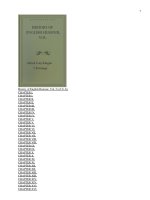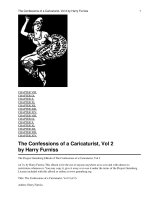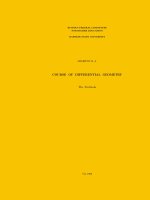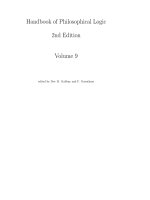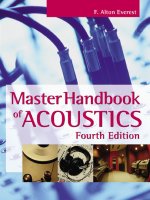- Trang chủ >>
- Đại cương >>
- Toán cao cấp
Dillen f verstraelen l (eds ) handbook of differential geometry vol 2
Bạn đang xem bản rút gọn của tài liệu. Xem và tải ngay bản đầy đủ của tài liệu tại đây (2.77 MB, 575 trang )
Handbook
of
Differential
Geometry
•
VOLUME II
This page intentionally left blank
Handbook
of
Differential
Geometry
•
VOLUME II
Editors
Franki J.E. Dillen
Leopold C.A. Verstraelen
Katholieke Universiteit Leuven
Department of Mathematics
Leuven, Belgium
Amsterdam • Boston • Heidelberg • London • New York • Oxford
Paris • San Diego • San Francisco • Singapore • Sydney • Tokyo
North-Holland is an imprint of Elsevier
ELSEVIER B.V.
Radarweg 29
P.O. Box 211, 1000 AE Amsterdam
The Netherlands
ELSEVIER Inc.
525 B Street, Suite 1900
San Diego, CA 92101-4495
USA
ELSEVIER Ltd
The Boulevard, Langford Lane
Kidlington, Oxford OX5 1GB
UK
ELSEVIER Ltd
84 Theobalds Road
London WC1X 8RR
UK
© 2006 Elsevier B.V. All rights reserved.
This work is protected under copyright by Elsevier B.V., and the following terms and conditions apply to its use:
Photocopying
Single photocopies of single chapters may be made for personal use as allowed by national copyright laws. Permission of the Publisher and payment of
a fee is required for all other photocopying, including multiple or systematic copying, copying for advertising or promotional purposes, resale, and all
forms of document delivery. Special rates are available for educational institutions that wish to make photocopies for non-profit educational classroom
use.
Permissions may be sought directly from Elsevier’s Rights Department in Oxford, UK: phone (+44) 1865 843830, fax (+44) 1865 853333, e-mail:
Requests may also be completed on-line via the Elsevier homepage ( />In the USA, users may clear permissions and make payments through the Copyright Clearance Center, Inc., 222 Rosewood Drive, Danvers, MA
01923, USA; phone: (+1) (978) 7508400, fax: (+1) (978) 7504744, and in the UK through the Copyright Licensing Agency Rapid Clearance Service
(CLARCS), 90 Tottenham Court Road, London W1P 0LP, UK; phone: (+44) 20 7631 5555; fax: (+44) 20 7631 5500. Other countries may have a local
reprographic rights agency for payments.
Derivative Works
Tables of contents may be reproduced for internal circulation, but permission of the Publisher is required for external resale or distribution of such
material. Permission of the Publisher is required for all other derivative works, including compilations and translations.
Electronic Storage or Usage
Permission of the Publisher is required to store or use electronically any material contained in this work, including any chapter or part of a chapter.
Except as outlined above, no part of this work may be reproduced, stored in a retrieval system or transmitted in any form or by any means, electronic,
mechanical, photocopying, recording or otherwise, without prior written permission of the Publisher.
Address permissions requests to: Elsevier’s Rights Department, at the fax and e-mail addresses noted above.
Notice
No responsibility is assumed by the Publisher for any injury and/or damage to persons or property as a matter of products liability, negligence or
otherwise, or from any use or operation of any methods, products, instructions or ideas contained in the material herein. Because of rapid advances in
the medical sciences, in particular, independent verification of diagnoses and drug dosages should be made.
First edition 2006
Library of Congress Cataloging in Publication Data
A catalog record is available from the Library of Congress.
British Library Cataloguing in Publication Data
A catalogue record is available from the British Library.
ISBN-13: 978-0-444-52052-4
ISBN-10: 0-444-52052-X
∞ The paper used in this publication meets the requirements of ANSI/NISO Z39.48-1992 (Permanence of Paper).
Printed in The Netherlands.
Dedication
In memory of S.S. Chern and T. Willmore
This page intentionally left blank
Preface
“Our goal with the volumes which together will constitute the “Handbook of Differential Geometry” is to give a rather complete survey of the field of differential geometry.”
Thus reads the opening sentence of the “Handbook of Differential Geometry, Volume I”,
and only the presence of the word “rather” saves this goal from being an obvious mission impossible. Let us recall the contents of this Volume I: Differential geometry of webs
(M.A. Akivis and V.V. Goldberg), Spaces of metrics and curvature functionals (D.E. Blair),
Riemannian submanifolds (B.-Y. Chen), Einstein metrics in dimension four (A. Derdzinski), The Atiyah–Singer index theorem (P.B. Gilkey), Survey of isospectral manifolds
(C.S. Gordon), Submanifolds with parallel fundamental form (Ü. Lumiste), Sphere theorems (K. Shiohama), Affine differential geometry (U. Simon), A survey on isoparametric
hypersurfaces and their generalizations (G. Thorbergsson), Curves (T. Willmore); with
introduction by S.S. Chern.
As in Volume I, we allowed the authors in this Volume II as much freedom as possible
concerning style and contents. We are confident that the reader will appreciate this pragmatic point of view. Some contributions will emphasize the basics; some will emphasize
the classical results; others the recent developments. Needless to say all authors have spent
a lot of time and energy in describing their topic, which we appreciate enormously.
The contributions to this Volume II are: Some problems on Finsler geometry (J.C. Álvarez Paiva), Foliations (R. Barre and A. El Kacimi), Symplectic geometry (A. Cannas da Silva), Metric Riemannian geometry (K. Fukaya), Contact geometry (H. Geiges),
Complex differential geometry (I. Mihai), Compendium on the geometry of Lagrange
spaces (R. Miron), Certain actual topics on modern Lorentzian geometry (F.J. Palomo
and A. Romero).
Obviously the whole field of differential geometry is not yet covered in the two volumes
of this “Handbook of Differential Geometry”. Some of the authors explicitly mention topics that should have been covered, but are not for practical reasons; but also other topics
are not (yet) treated sufficiently or not treated at all.
Recently Professors Chern and Willmore passed away. Both had a great impact on the
development of contemporary geometry and were genuine sources of inspiration, guidance
and support for many generations of mathematicians through their books and articles, their
fantastic lectures and their warm and truly concerned personal contacts. Together with
all authors we gratefully dedicate this book to the memories of Professor S.S. Chern and
Professor T.J. Willmore.
Franki Dillen and Leopold Verstraelen
vii
This page intentionally left blank
List of Contributors
Álvarez Paiva, J.C., Polytechnic University, Brooklyn, NY (Ch. 1).
Barre, R., Université de Valenciennes, Valenciennes (Ch. 2).
Cannas da Silva, A., Instituto Superior Técnico, Lisboa (Ch. 3).
El Kacimi Alaoui, A., Université de Valenciennes, Valenciennes (Ch. 2).
Fukaya, K., Kyoto University, Kyoto (Ch. 4).
Geiges, H., Universität zu Köln, Köln (Ch. 5).
Mihai, I., University of Bucharest, Bucharest (Ch. 6).
Miron, R., “Al.I. Cuza” University Iasi, Iasi (Ch. 7).
Palomo, F.J., Universidad de Málaga, Málaga (Ch. 8).
Romero, A., Universidad de Granada, Granada (Ch. 8).
ix
This page intentionally left blank
Contents
Preface
List of Contributors
Contents of Volume I
1. Some problems on Finsler geometry
J.C. Álvarez Paiva
2. Foliations
R. Barre and A. El Kacimi Alaoui
3. Symplectic geometry
A. Cannas da Silva
4. Metric Riemannian geometry
K. Fukaya
5. Contact geometry
H. Geiges
6. Complex differential geometry
I. Mihai
7. Compendium on the geometry of Lagrange spaces
R. Miron
8. Certain actual topics on modern Lorentzian geometry
F.J. Palomo and A. Romero
Author Index
Subject Index
vii
ix
xiii
1
35
79
189
315
383
437
513
547
555
xi
This page intentionally left blank
Contents of Volume I
Preface
Introduction
List of Contributors
1. Differential geometry of webs
M.A. Akivis and V.V. Goldberg
2. Spaces of metrics and curvature functionals
D.E. Blair
3. Riemannian submanifolds
B.-Y. Chen
4. Einstein metrics in dimension four
A. Derdzinski
5. The Atiyah–Singer index theorem
P.B. Gilkey
6. Survey of isospectral manifolds
C.S. Gordon
7. Submanifolds with parallel fundamental form
Ü. Lumiste
8. Sphere theorems
K. Shiohama
9. Affine differential geometry
U. Simon
10. A survey on isoparametric hypersurfaces and their generalizations
G. Thorbergsson
11. Curves
T. Willmore
Author Index
Subject Index
v
vii
ix
1
153
187
419
709
747
779
865
905
963
997
1025
1037
xiii
This page intentionally left blank
CHAPTER 1
Some Problems on Finsler Geometry∗
J.C. Álvarez Paiva∗∗
Department of Mathematics, Polytechnic University, Six MetroTech Center, Brooklyn, NY 11201, USA
E-mail:
We do like intuitive geometric arguments and uncovering
simple geometric reasons underlying seemingly recondite facts.
H. Busemann
Contents
1. Introduction . . . . . . . . . . . . . . . . . . . . .
2. Preliminaries . . . . . . . . . . . . . . . . . . . .
2.1. The Hamiltonian point of view . . . . . . . .
2.2. The Riemannian point of view . . . . . . . .
2.3. Isometries and isometric embeddings . . . .
2.4. Isometric submersions . . . . . . . . . . . .
3. Volume and area in Finsler spaces . . . . . . . . .
4. Unit spheres in Minkowski spaces . . . . . . . . .
5. Symplectic equivalence of Finsler manifolds . . .
5.1. Equivalence of unit co-disc bundles . . . . .
5.2. Equivalence of unit co-sphere bundles . . . .
5.3. Manifolds of geodesics . . . . . . . . . . . .
6. Around Hilbert’s fourth problem . . . . . . . . . .
7. Closed geodesics . . . . . . . . . . . . . . . . . .
8. Differential invariants of Finsler surfaces . . . . .
8.1. Convex geometry and the invariant I . . . .
8.2. The invariant J . . . . . . . . . . . . . . . .
8.3. Curvature of Finsler surfaces . . . . . . . . .
8.4. Cartan’s structure equations . . . . . . . . .
8.5. Applications of Cartan’s structure equations
References . . . . . . . . . . . . . . . . . . . . . . .
.
.
.
.
.
.
.
.
.
.
.
.
.
.
.
.
.
.
.
.
.
.
.
.
.
.
.
.
.
.
.
.
.
.
.
.
.
.
.
.
.
.
.
.
.
.
.
.
.
.
.
.
.
.
.
.
.
.
.
.
.
.
.
.
.
.
.
.
.
.
.
.
.
.
.
.
.
.
.
.
.
.
.
.
.
.
.
.
.
.
.
.
.
.
.
.
.
.
.
.
.
.
.
.
.
.
.
.
.
.
.
.
.
.
.
.
.
.
.
.
.
.
.
.
.
.
.
.
.
.
.
.
.
.
.
.
.
.
.
.
.
.
.
.
.
.
.
.
.
.
.
.
.
.
.
.
.
.
.
.
.
.
.
.
.
.
.
.
.
.
.
.
.
.
.
.
.
.
.
.
.
.
.
.
.
.
.
.
.
.
.
.
.
.
.
.
.
.
.
.
.
.
.
.
.
.
.
.
.
.
.
.
.
.
.
.
.
.
.
.
.
.
.
.
.
.
.
.
.
.
.
.
.
.
.
.
.
.
.
.
.
.
.
.
.
.
.
.
.
.
.
.
.
.
.
.
.
.
.
.
.
.
.
.
.
.
.
.
.
.
.
.
.
.
.
.
.
.
.
.
.
.
.
.
.
.
.
.
.
.
.
.
.
.
.
.
.
.
.
.
.
.
.
.
.
.
.
.
.
.
.
.
.
.
.
.
.
.
.
.
.
.
.
.
.
.
.
.
.
.
.
.
.
.
.
.
.
.
.
.
.
.
.
.
.
.
.
.
.
.
.
.
.
.
.
.
.
.
.
.
.
.
.
.
.
.
.
.
.
.
.
.
.
.
.
.
.
.
.
.
.
.
.
.
.
.
.
.
.
.
.
.
.
.
.
.
.
.
.
.
.
.
.
.
.
.
.
.
.
.
.
.
.
.
.
.
.
.
.
.
.
.
.
.
.
.
.
.
.
.
.
.
.
.
.
.
.
.
.
.
.
.
.
.
.
.
.
.
.
.
.
.
.
.
.
.
.
.
.
.
.
.
.
.
.
.
.
.
.
.
.
.
.
.
.
.
.
.
.
.
.
.
.
.
.
.
.
.
.
.
.
.
.
.
.
.
.
.
.
.
.
.
.
.
.
.
.
.
.
.
.
.
.
.
.
.
.
.
.
.
.
.
.
.
.
.
.
.
.
.
.
.
.
.
.
.
.
.
.
.
.
.
.
.
.
.
.
.
.
.
.
.
.
.
.
.
.
.
.
.
.
.
.
.
.
.
.
.
.
.
.
.
.
.
.
.
.
.
.
.
.
.
.
.
.
.
.
.
.
.
.
.
.
.
.
.
.
.
.
.
.
.
.
.
.
.
.
.
.
.
.
.
.
.
.
.
.
.
.
.
.
.
.
.
.
.
.
.
.
.
3
4
5
7
7
8
9
12
14
15
15
17
19
22
23
23
24
24
26
28
31
* This work was partially funded by a crédit aux chercheurs from the FNRS, Belgium.
** I warmly thank G. Berck, D. Burago, C. Durán, E. Fernandes, P. Foulon, I.M. Gelfand, R. Schneider, Z. Shen
and S. Tabachnikov for some very useful conversations and/or criticisms of earlier versions of this work.
HANDBOOK OF DIFFERENTIAL GEOMETRY, VOL. II
Edited by F.J.E. Dillen and L.C.A. Verstraelen
© 2006 Elsevier B.V. All rights reserved
1
2
J.C. Álvarez Paiva
Abstract
This chapter is an unorthodox survey of Finsler geometry presenting both results and open
problems. It aims to show that recent progress in convex geometry, the calculus of variations,
symplectic geometry, and integral geometry can be powerful tools in the study of Finsler
manifolds; and that Finsler geometry can prove useful in solving some of the open problems
in these fields.
Some problems on Finsler geometry
3
1. Introduction
Finsler manifolds, manifolds whose tangent spaces carry a norm that varies smoothly with
the base point, were born prematurely in 1854 together with their Riemannian counterparts
in Riemann’s ground-breaking Habilitationsvortrag. I say prematurely because in 1854
Minkowski’s work on normed spaces and convex bodies (see [69]) was still forty three
years away, and thus not even the infinitesimal geometry on which Finsler manifolds are
based was understood or appreciated at the time. Apparently, Riemann did not know what
to make of these ‘more general class’ of manifolds whose element of arclength does not
originate from a scalar product and, fatefully, put in a bad word for them [44]:
Investigation of this more general class would actually require no essential different principles,
but it would be rather time-consuming and throw relatively little new light on the study of Space,
especially since the results cannot be expressed geometrically.
Given the awe with which we rightfully regard Riemann’s achievements and uncanny
geometrical intuition, it is tempting to take the above quotation out of historical context
and to dismiss Finsler geometry altogether. But, if we think of the great advances in convex
geometry, the calculus of variations, integral geometry, the theory of metric spaces, and
symplectic geometry that have taken place since 1854, then we may be moved to reassess
Riemann’s statement and to consider applying these new tools to develop the subject in a
way that Riemann could not have foreseen.
The paper includes eighteen simply-stated open problems, as well as a survey of the
more elementary and geometric chapters of Finsler geometry. It presents a detailed discussion of the Holmes–Thompson volume and its role in integral geometry and geometric
inequalities, thus complementing the survey by Álvarez and Thompson [16]. The other
highlights of the paper are its presentation of Hilbert’s fourth problem and its elementary
approach to the differential invariants of Finsler surfaces. These are mostly based on the papers [15,12,13] with I.M. Gelfand, M. Smirnov and E. Fernandes, as well as on the lecture
notes [10] written jointly with C. Durán.
In view of the often-made criticisms of Finsler geometry—very few concrete and interesting examples, very few non-Riemannian theorems of real geometric content, and too
many subindices—I have tried to include as many concrete examples, simply-stated results, and geometric constructions as possible. In this way, many of the jewels, so to speak,
of Finsler geometry find their way into the following pages.
As anyone writing a survey paper, I have had to make some choices. In matters of taste,
I have consistently preferred the concrete to the abstract, the elementary to the advanced,
the C ∞ to the C k , and the global to the local. I have stayed clear of Riemann–Finsler
geometry and Finsler connections because the book [23] of Bao, Chern and Shen covers
the subject in depth as do the lecture notes of Abate and Patrizio [1]. Because of my ignorance of the subject, I have not touched on complex Finsler geometry (see [1] also for this
topic) and, despite their undeniable interest and importance, non-reversible Finsler metrics
are barely mentioned. Another important topic that is not covered in this survey is Busemann’s G-spaces. This approach, which consists in abstracting the properties of geodesics
on Finsler manifolds, is one of the most powerful in Finsler geometry, but it is impossible
to outdo Busemann’s own exposition in [37,38].
4
J.C. Álvarez Paiva
The reader wishing to have a broader view of the activity in Finsler geometry should
read the short surveys of Chern [44] and Busemann [35]. The book [20] contains survey
articles on several topics including non-reversible Finsler metrics, the proceedings [22]
contains many open problems and a vista of various approaches to Finsler geometry. The
book [84] contains a beautiful exposition of the convex-geometric aspects of the Holmes–
Thompson volume as well as most of the convex geometry necessary for the study of
Finsler manifolds. The lecture notes [10] are similar in spirit to the present paper. The
thesis of Egloff [46] is a good place to learn about the beautiful results of Egloff [47,48]
and Foulon [50–52] on the geometry and dynamics of Finsler manifolds with non-positive
and negative curvature. Finally, I wholeheartedly recommend looking at the papers [42]
and [3] before plunging into other papers where Finsler connections are treated.
The reader can find many of the preprints cited in this paper, along with other
works on the interaction between convex, integral, metric, and symplectic geometry, in
/>2. Preliminaries
If (V , · ) is a real, finite-dimensional normed space, we define the length of a smooth
curve γ : [a, b] → V by the formula
b
length of γ :=
γ˙ (t) dt.
a
A smooth submanifold N ⊂ V inherits a metric from the norm: if x and y are two points
on N , define their distance as the infimum of the lengths of all smooth curves on N joining
x and y. Notice that in order to define the metric on N it suffices to know the restriction of
the norm to each tangent space. This motivates the following heuristic definition: A Finsler
manifold is a manifold together with the choice of a norm on each tangent space. The
precise definition requires us to restrict the class of norms to those where the unit sphere
is smooth and quadratically convex (i.e., it has positive principal curvatures for some (and
therefore any) Euclidean structure on V ). The intrinsic definition of these norms is as
follows:
Let V be a vector space and let ϕ : V → [0, ∞) be a norm that is smooth outside the
origin. Set L := ϕ 2 /2 and consider the exterior derivative of L, dL, as a map from V
minus the origin to V ∗ minus the origin. The norm ϕ is said to be a Minkowski norm if dL
is a diffeomorphism.
For any non-zero vector v ∈ V , the differential
D(dL)(v) : Tv V → TdL(v) V ∗
is an invertible linear map. In fact, using the natural identification of Tv V with V ,
and TdL(v) V ∗ with V ∗ , we can think of gϕ (v) := D(dL)(v) as a (symmetric) bilinear form
on V :
gϕ (v)(w1 , w2 ) := D(dL)(v)(w1 ) (w2 ).
Some problems on Finsler geometry
5
The norm ϕ is a Minkowski norm if and only if gϕ is positive definite. When the vector v
belongs to the unit sphere, we will denote gϕ (v) as the osculating Euclidean structure at v
and the ellipsoid
Ev := w ∈ V : gϕ (v)(w, w) = 1
as the osculating ellipsoid at v.
D EFINITION 2.1. A Finsler metric on a manifold M is a continuous function defined on
its tangent bundle with the property that it is smooth away from the zero section and its
restriction to each tangent space is a Minkowski norm.
Some examples of Finsler manifolds are submanifolds of Minkowski spaces and flat tori
obtained as quotients of Minkowski spaces.
If γ : [a, b] → M is a smooth curve on a Finsler manifold (M, ϕ), then the quantity
b
length of γ :=
ϕ γ˙ (t) dt
(1)
a
is independent of the parameterization. Using this definition of length we define a metric
on M by letting the distance between two points x, y ∈ M to be the infimum of the lengths
of all smooth curves joining x and y. Finsler manifolds are length spaces: the length of a
curve γ defined by the integral in (1) equals the metric length of the curve given by
k−1
dist γ (ti ), γ (ti+1 ) : a = t0 < · · · < tk = b is a partition of [a, b] .
sup
i=0
The condition that the norms in each tangent space be Minkowski norms is necessary
for the study of the geodesics. Namely, we want these to be solutions of a second-order
differential equation on M.
2.1. The Hamiltonian point of view
If (V , ϕ) is a normed space, then the dual vector space V ∗ inherits a natural norm defined
by the equation
ϕ ∗ (ξ ) := sup ξ (v) : ϕ(v)
1 .
A related construction on Minkowski spaces is the Legendre transform which assigns to
a non-zero vector v ∈ V the covector ϕ(v) dϕ(v) = gϕ (v)(v, ·). It is easy to check that if
v belongs to the unit sphere S ⊂ (V , ϕ), then the Legendre transform of v is the unique
covector ξ such that ξ = 1 is the hyperplane tangent to S at the point v. This implies that
the image of S under the Legendre transform is the unit sphere in (V ∗ , ϕ ∗ ).
6
J.C. Álvarez Paiva
Let (M, ϕ) be a Finsler manifold and for each point m ∈ M let ϕm denote the Minkowski
∗ ) is the dual of the normed space (T M, ϕ ), then the function
norm on Tm M. If (Tm∗ M, ϕm
m
m
H : T ∗M → R
∗ (p ) is a Hamiltonian whose energy surfaces are fiber-wise condefined by H (pm ) := ϕm
m
vex. Applying the Legendre transform on each tangent space of M defines a diffeomorphism L : T M \ 0 → T ∗ M \ 0 with the property that H ◦ L = ϕ.
By passing from a Finsler metric to its associated Hamiltonian, we gain access to the
techniques of Hamiltonian mechanics and symplectic geometry. Below, we recall some of
the basic definitions and constructions. For more information see [18] and [2].
D EFINITION 2.2. Let π : T ∗ M → M be the standard projection and let Dπ : T (T ∗ M) →
T M be its differential. The canonical 1-form α on T ∗ M is defined by the equation
α(vpm ) = pm (Dπ(vpm )), where pm ∈ Tm∗ M and vpm ∈ Tpm (T ∗ M). The symplectic 2-form
is defined as ω := −dα.
The form ω is non-degenerate: at each point pm ∈ T ∗ M, the map vpm → ωpm (vpm , ·) is
an isomorphism from Tpm (T ∗ M) to Tp∗m (T ∗ M). We can use this isomorphism to pass from
1-forms on T ∗ M to vector fields on T ∗ M.
D EFINITION 2.3. Let H : T ∗ M → R be a smooth function. The Hamiltonian vector field
of H , XH , is defined by the equality dH = ω(XH , ·).
As an easy consequence of the definition, we have that H is constant along the integral
curves of the Hamiltonian vector field XH , and that the symplectic form is invariant under
the flow of XH .
Because of this result, it is usual to disregard the function H in favor of the unit co∗ M := H −1 (1). If α is the canonical 1-form on T ∗ M, then its restriction
sphere bundle SH
∗ M, which we denote by α , is a contact form (i.e., the
to the unit co-sphere bundle SH
H
n−1
never vanishes). Using αH , we can define the restriction
top-order form αH ∧ (dαH )
of the Hamiltonian vector field XH without any reference to the function H :
∗ M is defined by the equations
D EFINITION 2.4. The Reeb vector field XH on SH
αH (XH ) = 1,
dαH (XH , ·) = 0.
The projection to M of the integral curves of this vector field are geodesics parameterized with unit speed. Conversely, if γ is a geodesic on M parameterized with unit speed,
then the Legendre transform L maps the velocity curve γ˙ to an orbit of the Reeb vector
field. We remark that if γ is any smooth curve on M parameterized with unit speed, then
length of γ =
L◦γ
αH .
(2)
Some problems on Finsler geometry
7
Note that the Finsler manifold (M, ϕ) is geodesically complete (or metrically complete,
since it is easy to verify that the Hopf–Rinow theorem extends to the Finsler setting) if and
only if the Reeb vector field defines a flow.
Let us finish this section by remarking that the non-degeneracy of the symplectic form ω
on T ∗ M is equivalent to the fact that ωn , n = dim(M), is a volume form. This remark will
provide us with a natural way to define the volume of a Finsler manifold.
2.2. The Riemannian point of view
Finsler manifolds can also be studied from the point of view of Riemannian manifolds and
bundles. Indeed, to every unit vector vm ∈ Tm M we may associate the inner product gϕ (v).
In this way, we can define a Riemannian structure on the pullback of the tangent bundle of
M to the unit tangent bundle of M. This construction underlies many of the definitions of
connections associated to Finsler manifolds.
A variation on this theme is to take a nowhere zero vector field X defined on an open subset O ⊂ M and to associate to it the Riemannian metric on O defined by m → gϕ (X(m)).
This construction has been used by Shen (see [79] and Section 8) to give a simple description of the Finsler curvature.
2.3. Isometries and isometric embeddings
The definitions of isometry and isometric embedding between Finsler manifolds (M, ϕM )
and (N, ϕN ) are the same as for Riemannian manifolds. Namely, an isometry (respectively
isometric embedding) is a diffeomorphism (respectively embedding) f : M → N such that
f ∗ ϕN = ϕM . Unlike Riemannian manifolds, two Finsler manifolds can fail to be isometric
because of what happens at a single tangent space. For example, if at a point m ∈ M the
indicatrix
Sm M := vm ∈ Tm M: ϕM (vm ) = 1
is an ellipsoid while none of the indicatrices of N are ellipsoids, then M and N are not
isometric. This remark points at the important role played by the centro-affine geometry of
convex hypersurfaces in Finsler geometry.
In [32] Burago and Ivanov showed that any compact Finsler manifold admits an isometric embedding into a finite-dimensional normed space. It is likely, but unproved, that
the norm can be chosen to be a Minkowski norm. They also give examples of noncompact Finsler manifolds that cannot be isometrically embedded in any finite-dimensional
normed space. Examples of Finsler manifolds that cannot be isometrically embedded in
any Minkowski space have been given by Shen (see [79]) and by Álvarez and Durán (see
Section 8.5).
However, new types of embedding problems arise in Finsler geometry. For example,
while it is known that every two-dimensional normed space is isometric to a subspace
of L1 ([0, 1]) (see, for example, [29]), it is not clear whether the following problem has an
affirmative answer.
8
J.C. Álvarez Paiva
P ROBLEM 1. Does every two-dimensional Finsler manifold admit an isometric embedding
into the Banach space L1 ([0, 1])?
The relation between intrinsic and extrinsic geometric properties of submanifolds of
normed space is not understood. For example, the following problem from [84] is open.
P ROBLEM 2 (Thompson). Let X and Y be two normed spaces of dimension n, n > 2,
such that its unit spheres are isometric as Finsler manifolds. Does it follow that X and Y
are isometric as normed spaces?
2.4. Isometric submersions
In Riemannian geometry isometric submersions are used to construct examples of Riemannian manifolds while keeping some control on their geodesics and curvature. The
Finslerian generalization of this construction is simple, but perhaps not as well known
as it should be. What follows is taken from [11].
D EFINITION 2.5. A surjective linear map π : X → Y between two normed spaces is said
to be an isometric submersion if the image of the closed unit ball on X under the map π
equals the closed unit ball on Y .
Clearly, if x is any vector in X, then π(x) Y
x X . The vectors for which the equality
holds are called horizontal vectors and form the horizontal cone in X. Notice that if the
unit sphere in X is smooth, its intersection with the horizontal cone is the singular set of
the restriction of the map π to the unit sphere. This description makes it easy to grasp that,
unlike the case where the spaces is Euclidean, the horizontal cone is rarely a subspace.
D EFINITION 2.6. A submersion ρ : M → N between Finsler manifolds is said to be isometric if for every point m ∈ M the differential
Dm ρ : Tm M → Tρ(m) N
is an isometric submersion of normed spaces.
More generally, Berestovskii has defined in [24] isometric submersions, or submetries of
metric spaces, as maps that send metric balls to metric balls of the same radius. When the
metric spaces are Finsler manifolds both notions of isometric submersion agree. However,
in the particular case of Finsler manifolds we can also speak of horizontal lifts.
D EFINITION 2.7. Let ρ : M → N be an isometric submersion. An immersed curve
γ : [a, b] → M is said to be horizontal if for every t ∈ (a, b) the velocity vector γ˙ (t) belongs to the horizontal cone in Tγ (t) M. A curve γ : [a, b] → M is said to be a horizontal
lift of an immersed curve σ : [a, b] → N if γ is horizontal and ρ ◦ γ = σ .
Some problems on Finsler geometry
9
The following result is an easy consequence of the definitions and of the basic properties
of geodesics in a Finsler manifold.
T HEOREM 2.8 (Álvarez and Durán [11]). An immersed curve on N is a geodesic if and
only if any of its horizontal lifts is a geodesic on M. In particular, the geodesics of N are
precisely the projections of horizontal geodesics on M.
As we shall see in Section 6, this theorem is useful in constructing interesting examples
of Finsler metrics on complex and quaternionic projective spaces.
3. Volume and area in Finsler spaces
The theory of volume and area in normed spaces has long been a major driving force in
convex geometry. For example, the Blaschke–Santaló inequality, the Mahler conjecture, the
Busemann–Petty problems, the Shephard problem, and the numerous works of Busemann,
Ewald and Shephard on the notions of convexity on Grassmannians originated from or
have applications to the study of volumes and areas in normed spaces (see [16]).
Defining a volume on a finite-dimensional normed space seems easy: a natural volume
should be invariant under translations, positive on open sets, and finite on compact sets. By
Haar’s theorem, such a volume must be a multiple of the Lebesgue measure. However, the
choice of this multiple is crucial. To understand this, suppose we have already decided on
how to assign those constants to two-dimensional normed spaces. We can now define the
area of a two-dimensional polyhedral surface embedded in a 3-dimensional normed space
as the sum of the areas of its faces with their induced norms. Making a different choice of
constants leads to a completely different way of measuring the area of polyhedral surfaces.
The guiding principle in defining volumes on normed spaces is that the choice of a
volume for every k-dimensional normed space leads to the definition of the k-volume integrand in all higher-dimensional normed spaces. Requiring even mild conditions on these
area integrands, such as that regions in hyperplanes be area-minimizing, severely restricts
our choices for a definition of volume. In fact, in the literature one can only find three
reasonable choices of volume on normed spaces: the Busemann definition, the Holmes–
Thompson definition, and the Benson definition (also known as Gromov’s mass∗ [56]).
Since the Busemann volume of a Finsler manifold coincides with its Hausdorff measure
as a metric space, at first sight it seems the most natural and geometric definition. However,
the Holmes–Thompson definition, with its ties to Brunn–Minkowski theory, integral, and
symplectic geometry, is rapidly becoming the definition of choice.
D EFINITION 3.1. The Holmes–Thompson volume of an n-dimensional Finsler manifold (M, ϕ), voln (M, ϕ), is the symplectic volume of its unit co-disc bundle divided by
the volume of the Euclidean n-dimensional unit ball. The k-volume of a k-dimensional
submanifold is the volume of the submanifold with its induced Finsler metric.
10
J.C. Álvarez Paiva
Note that, using the notation of the previous section, we have that
voln (M) =
1
n n!
∗M
SH
αH ∧ (dαH )n−1 ,
(3)
where n is the volume of the Euclidean unit ball of dimension n.
Using the Blaschke–Santaló inequality, Durán has remarked in [45] that the Hausdorff
measure of a Finsler manifold is no less than its Holmes–Thompson volume. Equality holds
if and only if the metric is Riemannian.
One of the basic problems about a given definition of volume on normed and Finsler
spaces is determining the convexity or ellipticity properties of the k-volume integrands.
Perhaps the most enticing and difficult question of the kind is the following problem of
Busemann:
P ROBLEM 3. Let P be a compact polyhedron of dimension k in a normed space. Is the
k-volume of any given face less than or equal to the sum of the k-volumes of the remaining
faces?
In the case of polyhedra of codimension one the answer to this question is affirmative for
both the Hausdorff measure (Busemann [34]) and the Holmes–Thompson volume (Holmes
and Thompson [62]).
For the Hausdorff measure no other results of this kind are known. For the Holmes–
Thompson volume the answer to Busemann’s question is known to be affirmative if the
normed space is a subspace of L1 ([0, 1]):
T HEOREM 3.2 (Busemann et al. [40]). Let P be a compact polyhedron of dimension k in
the Banach space L1 ([0, 1]). The (Holmes–Thompson) k-volume of any given face is less
than or equal to the sum of the k-volumes of the remaining faces.
The latest progress on the question of minimality of flats in normed spaces is the following result of Burago and Ivanov:
T HEOREM 3.3 (Burago and Ivanov [33]). Let P be a compact 2-dimensional polyhedron in a normed space. If P is homeomorphic to a sphere, then the (Holmes–Thompson)
2-volume of any given face is less than or equal to the sum of the 2-volumes of the remaining faces.
In [64], S. Ivanov shows that this result can be extended to a theorem that is new even in
the Riemannian case:
T HEOREM 3.4 (Ivanov [64]). Let ϕ be a Finsler metric on the closed two-dimensional disc
D such that every two points on D are joined by a unique geodesic. If ψ is another Finsler
metric on D such that the distance induced by ψ on the boundary ∂D of D is greater than
or equal to the distance induced by ϕ on ∂D, then the Holmes–Thompson volume of (D, ϕ)
does not exceed that of (D, ψ).

